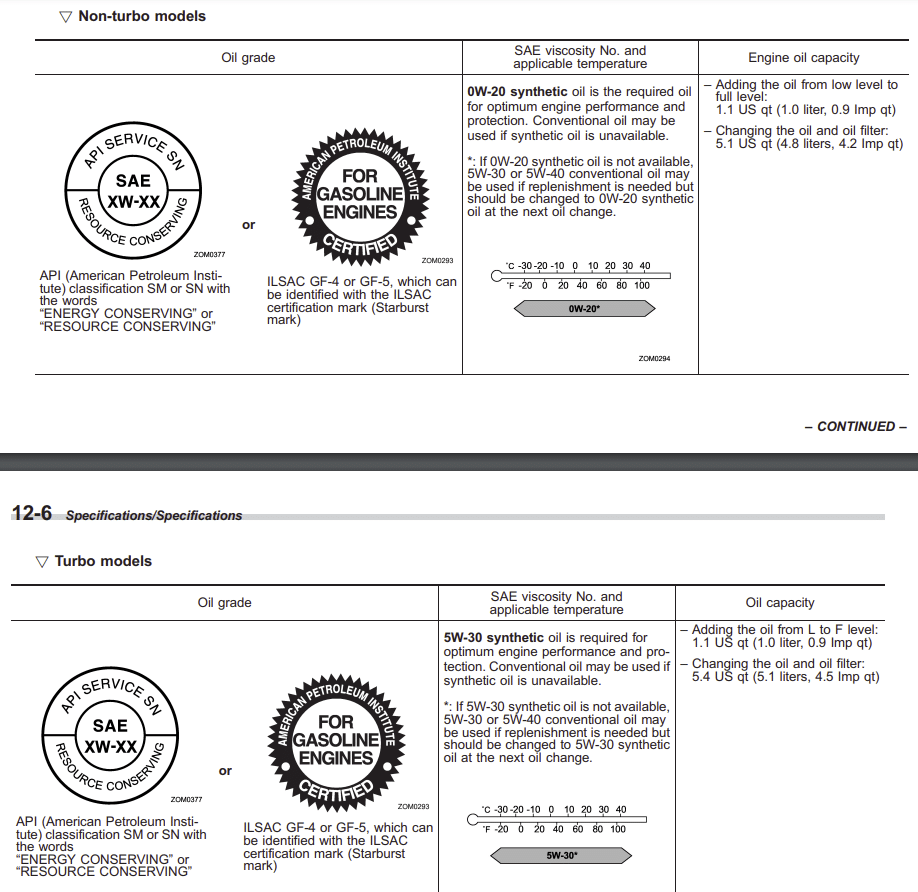The 2015 Subaru Forester is a versatile, reliable, compact SUV known for its all-wheel-drive capability, fuel efficiency, and comfortable cabin space. It comes in various trims and configurations, including non-turbo and turbo models. Designed to handle diverse driving conditions, the Forester has gained popularity among outdoor enthusiasts and families alike.
Using the correct oil type in your 2015 Subaru Forester is crucial for maintaining optimal engine performance and protection. The right oil will ensure proper lubrication, reduce friction, and prevent wear and tear on the engine components. Additionally, using the appropriate oil type can improve fuel efficiency, reduce emissions, and extend the overall lifespan of your vehicle.
Following the manufacturer’s recommendations for oil type and viscosity ensures that your Forester’s engine will continue to operate efficiently and reliably throughout its life.
What Oil Should I Use in My 2015 Subaru Forester?
Non-turbo Models
For optimal engine performance and protection in non-turbo 2.5L 2015 Subaru Forester models, 0W-20 synthetic oil is recommended. Synthetic oil provides better lubrication, increased resistance to thermal breakdown, and improved protection against engine wear compared to conventional oil.
In situations where 0W-20 synthetic oil is not available, you may use 5W-30 or 5W-40 conventional oil as a temporary alternative. However, it is important to switch back to 0W-20 synthetic oil at the next oil change to ensure your engine’s best performance and protection.
Turbo Models
For 2.0L Turbo 2015 Subaru Forester models, 5W-30 synthetic oil is required to achieve optimal engine performance and protection. The synthetic oil formulation provides superior lubrication, better heat resistance, and enhanced protection against wear for the high-performance demands of turbocharged engines.
If 5W-30 synthetic oil is unavailable, you may use 5W-30 or 5W-40 conventional oil as a temporary substitute. However, changing the oil back to 5W-30 synthetic oil at the next oil change is crucial to maintain the best possible engine performance and protection for your turbocharged Forester.

It is essential to adhere to these capacities to maintain proper lubrication and engine protection. Regularly checking and adjusting the oil level helps ensure the longevity and optimal performance of your 2015 Subaru Forester.
Engine Oil Capacity for 2015 Subaru Forester Models
Proper maintenance of your 2015 Subaru Forester includes regularly checking and changing the engine oil. In this section, we will discuss the importance of monitoring the oil level, the steps to check the oil level using the oil level gauge, and the procedure for changing the oil and oil filter. Following these guidelines will help you maintain your Forester’s engine performance and longevity.
2.5L Subaru Forester Oil Capacity
When performing an oil and oil filter change on non-turbo 2015 Subaru Forester models, the required engine oil capacity is 5.1 US qt (4.8 liters, 4.2 Imp qt). This ensures proper lubrication and engine protection.
If you need to top off the oil between changes for non-turbo models, the capacity for adding oil from the low level to the full level is 1.1 US qt (1.0 liter, 0.9 Imp qt).
2.0L Turbo Subaru Forester Oil Capacity
For turbocharged 2015 Subaru Forester models, the engine oil capacity when changing the oil and oil filter is 5.4 US qt (5.1 liters, 4.5 Imp qt). This is necessary to maintain optimal engine performance and protection.
When topping off the oil between changes for turbo models, the capacity for adding oil from the low level to the full level is 1.1 US qt (1.0 liter, 0.9 Imp qt).
Understanding Oil Types and Specifications
API (American Petroleum Institute) classification and ILSAC (International Lubricant Standardization and Approval Committee) certification are essential indicators of engine oil quality and performance. API classifications, such as SM or SN, represent the oil’s performance level and compatibility with specific engine types.
ILSAC certifications, like GF-4 or GF-5, indicate that the oil meets a set of strict performance criteria and fuel economy standards. Look for the API classification and ILSAC certification on the oil container to ensure that you are using the correct oil for your 2015 Subaru Forester.
Synthetic oil is a chemically engineered lubricant designed to offer superior performance compared to conventional oil. It provides better resistance to thermal breakdown, improved lubrication at extreme temperatures, and enhanced protection against engine wear. Conventional oil, derived from crude oil, offers basic engine protection but may not provide the same level of performance as synthetic oil, especially under demanding driving conditions.
Energy-conserving and resource-conserving oils are designed to improve fuel efficiency, reduce emissions, and minimize the environmental impact of engine operation. These oils typically have lower viscosity, which reduces internal engine friction and improves fuel economy. When selecting oil for your 2015 Subaru Forester, look for the words “Energy Conserving” or “Resource Conserving” on the API classification or ILSAC certification labels to ensure that you are using an environmentally friendly and fuel-efficient oil.
How to Check and Change the Engine Oil
Regularly checking the oil level in your 2015 Subaru Forester is crucial for maintaining engine performance, protection, and longevity. Insufficient oil levels can lead to increased friction, overheating, and potential damage to engine components. Conversely, overfilling can cause excessive oil pressure and other issues. Monitoring the oil level ensures your engine has the appropriate amount of lubrication to function efficiently.
Steps To Check The Oil Level Using The Oil Level Gauge
- Park your Forester on a level surface and turn off the engine. Allow it to cool down for a few minutes to settle the oil.
- Open the hood and locate the engine oil dipstick, usually marked with a brightly colored handle.
- Pull out the dipstick, wipe it clean with a lint-free cloth or paper towel, and reinsert it fully into its tube.
- Remove the dipstick again and check the oil level. It should be between the “L” (low) and “F” (full) marks.
- If the level is below the “L” mark, add the recommended oil type in small increments, checking the level again after each addition until it reaches the appropriate level.
- Reinsert the dipstick securely and close the hood.
Procedure For Changing The Oil And Oil Filter
- Warm up the engine to ensure the oil flows more easily, then park your Forester on a level surface and turn off the engine.
- Lift and safely support the vehicle using jack stands, ramps, or a lift.
- Locate the oil drain plug underneath the engine and place an oil drain pan beneath it.
- Remove the oil drain plug using a wrench or socket, and allow the oil to drain completely into the pan.
- While the oil drains, remove the oil filter by turning it counterclockwise. Use an oil filter wrench if necessary.
- Lubricate the gasket of the new oil filter with a small amount of fresh oil, then screw the filter onto the engine by hand until it’s snug. Tighten it an additional 3/4 turn using the oil filter wrench.
- Clean the drain plug and reinstall it, tightening it securely.
- Lower the vehicle and remove the oil filler cap on the top of the engine.
- Refill the engine with the recommended oil type, using the appropriate capacity for your Forester model. Check the oil level using the dipstick, ensuring it is between the “L” and “F” marks.
- Replace the oil filler cap, start the engine, and let it run for a few minutes. Check for any leaks around the oil filter and drain plug.
- Turn off the engine, wait a few minutes for the oil to settle, then check the oil level again, adding more oil if necessary.
- Properly dispose of the used oil and oil filter at a designated recycling center or auto parts store.
Regular oil changes, typically every 6,000 miles or 6 months, will help maintain the performance and longevity of your 2015 Subaru Forester’s engine.
Conclusion
Using the correct oil type in your 2015 Subaru Forester is vital for optimal engine performance, protection, and longevity. Adhering to the manufacturer’s recommendations for oil type and viscosity ensures proper lubrication, reduces friction, and prevents wear and tear on the engine components. Additionally, using the appropriate oil type can improve fuel efficiency, reduce emissions, and extend the overall lifespan of your vehicle.
- Regularly check and adjust the oil level in your Forester, ensuring it is within the appropriate range between the “L” and “F” marks on the dipstick.
- Follow the manufacturer’s recommended oil change intervals, typically every 6,000 miles.
- Always use the recommended oil type and viscosity for your specific Forester model, whether it is a non-turbo or turbo variant.
- When changing the oil, also replace the oil filter to ensure proper filtration and engine protection.
- Monitor your engine’s performance and address any issues or concerns promptly to maintain the health of your Forester’s engine.







